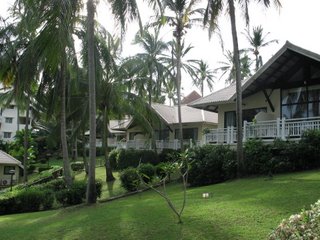"Annebelle" again pitched in to help. It was a relatively cool day (20 deg C) with just a hint of very light drizzle at times so the working conditions were pleasant plus the grapes were not getting too hot. Low temperature fermentation is a prerequisite for good white wine. In our vin de garage winery environment where refrigeration is out of the question ambient conditions are important. However we will never reach the preferred 10-16 deg C range for whites during our summer.
The grapes were in excellent condition. The small amount of botrytis that had broken out had been stopped in its tracks by the long hot dry summer and the affected berries had shriveled to the point of being inconsequential for good wine production.
Sugar level was 12.5 deg Baume and pH 3.2. Absolutely no complaints about that.
The grapes were immediately crushed and destemmed. We continually added a combination of sulphur dioxide (50mg/L) and ascorbic acid (50mg/L) at the crusher to prevent juice oxidation.
Sulphur dioxide (SO2) is produced by adding potassium metabisulphite (KMS) to water. 1.0g of KMS produces approximately 0.5g of SO2.
To the resultant must (juice + skins) we added a pectin splitting enzyme to increase the yield of drained juice.
The must was then drained through the press and the skins very lightly pressed. Free run juice makes the best white wine. Over pressed whites tend to absorb the phenolics and tannins present in the skins and any residual stalks and reduce the quality of the wine.
More SO2 (25mg/L) was added at the press.
The juice was then transferred to a stainless steel tank and DAP (fermentation accelerator) and a rehydrated white wine specific yeast added.
 | |
| Draining the Semillon |
Fermentation took 36 hours to start. The addition of SO2 in the initial stages of production inhibits the onset of fermentation so it always takes longer to start than red wine. This lag is a bit of a critical time for vin de garage wineries with the juice exposed to oxidation, hence our care with the correct additions of SO2 / ascorbic acid at the appropriate times.
Proper wineries employ reductive oenology ie. preventing juice and wine being exposed to air eg. use of CO2, combined with effective temperature control.
 |
| The Semillon marc |
Meanwhile the Tempranillo continues to ferment vigorously. We are punching the cap down every four hours during the day. Colour is excellent, a dense purple/red. On the 11th February sugar level was 4.0 deg Baume, so we have just a little way to go until fermentation is complete. pH is 3.8 but will change ie. increase, as the ferment progresses and after MLF is finished. Our target is 3.6. We will need to do some acid adjustment.
 |
| The Cap: Fully formed; Half punched down; Fully punched down |
MLF or malolactic fermentation is the conversion of one of the natural grape acids, malic acid into the more stable and less harsh lactic acid by lactic acid bacteria. We added a lactic acid culture at the beginning of the fermentation process. MLF is not really fermentation but is called such as carbon dioxide is released during the conversion. Adding the culture early gives it the opportunity to work while the true fermentation is taking place. Waiting until this is over to add the culture (or waiting for the process to occur naturally) is 'dangerous' from an oxidation point of view as the lactic acid bacteria are very sensitive to SO2. This could mean no protection for the finished wine for a considerable time.
pH is the measure of acid activity in the wine, not the actual acid content ie.TA or titratable acidity.
We use a simple pen style pH meter. It has an accuracy of 0.05 units and automatic temperature compensation.
pH is important because at the required level (around 3.3 for whites and 3.5 for reds) the wine is protected from microbial spoilage as well as giving many of the chemical additions the best conditions in which to work.
For example, the most active component of SO2 is molecular sulphur. The lower the pH the higher the content of molecular sulphur in the SO2 addition. Therefore this chemical's activity against microbes and oxygen is optimized at the 'right' pH.
Weather forecast for the next 3 days is rain periods. Not drought breaking but 50mm is expected.
I am sure we will be harvesting the Pinot Noir not long after this rain event is over.






















No comments:
Post a Comment